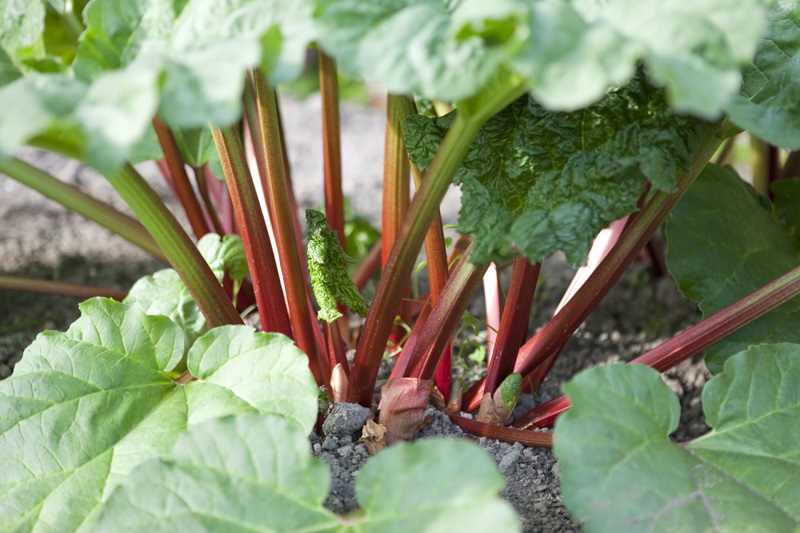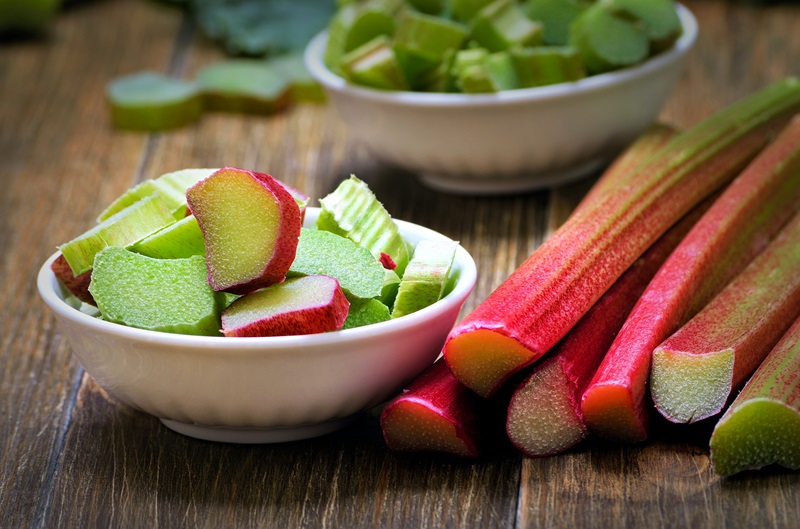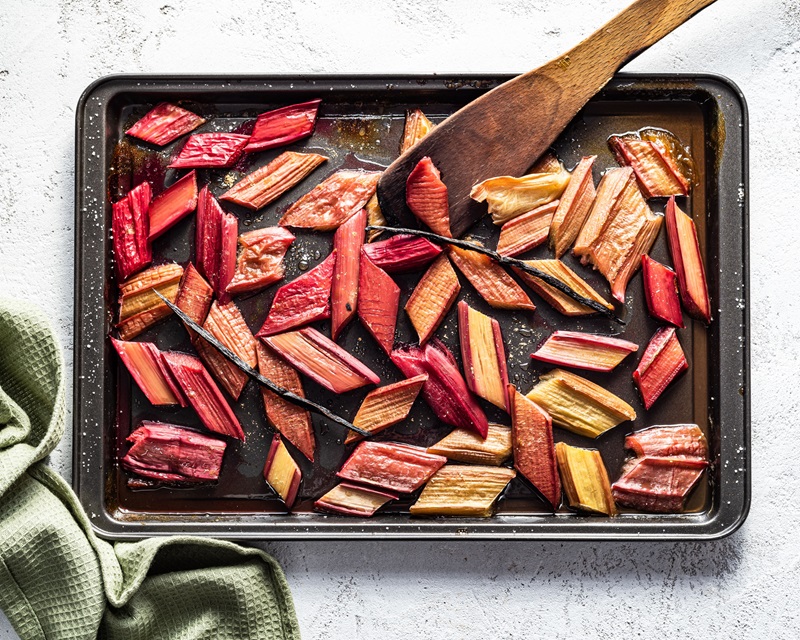Rhubarb might be the most powerful, least appreciated superfood. If you are familiar with rhubarb at all, it’s probably because you’ve eaten it in a pie. However, the red stalks are not just a dessert ingredient. Rhubarb is packed with essential nutrients and health benefits.
Rhubarb has a distinctive tart flavor that complements sweet ingredients, adding depth to the flavor of baked goods and other treats. You can also use rhubarb to punch up the flavor of healthy meals that fit perfectly into your Nutrisystem plan. This edition of Superfood Spotlight is dedicated to helping you discover the pleasures and possibilities of this simple but extra-nutritious food.
What is Rhubarb?

While rhubarb is often served as part of fruit-based dishes, it is a vegetable. It has long stalks that are deep pink to reddish and green leaves. Only the stalks, however, are edible. The leaves contain high concentrations of oxalic acid, which may promote the formation of kidney stones, and they are best avoided.
Rhubarb was used primarily as a medicinal plant by people living in ancient China and in the historic Greek, Roman and Arab civilizations. It was believed to be a natural remedy for inflammation and to help heal wounds. In the time of our grandparents and great grandparents, strawberry rhubarb pies were a welcome sign that spring had arrived.
Nutritional Profile of Rhubarb: A Low-Calorie Powerhouse

A half-cup serving of fresh rhubarb comes with 13 calories, zero grams of fat and one gram fiber, according to the United States Department of Agriculture (USDA). Rhubarb gives you substantial amounts of calcium and potassium, which play a key role in regulating your metabolism. It’s also a good source of vitamins A and C, B vitamins, and iron.
That serving of rhubarb provides more than 20 percent of your Recommended Daily Allowance for vitamin K, a nutrient necessary for bone formation and blood-clotting. Note that consuming foods high in vitamin K can interfere with blood-thinning medications, so if you take them be sure to check in with your healthcare provider before you add rhubarb to your diet.
Rhubarb gets its rosy hue from anthocyanins, a potent micronutrient found in other colorful fruits and vegetables such as red grapes and eggplant. These naturally occurring compounds are antioxidants, meaning that they neutralize damaging free radical cells in our bodies. Rhubarb contains over 42 different types of phytonutrients, tiny but impactful compounds found only in plant-based foods, says a report from Penn State University.
The Compelling Health Benefits of Rhubarb

Rhubarb is often overshadowed by its common use in desserts, particularly pies. Yet, this vibrant vegetable offers an array of health benefits, packed with essential nutrients that can significantly bolster your well-being.
The anthocyanins in this plant have been shown to have anti-bacterial and anti-inflammatory properties, which help protect you from heart disease, cancer and diabetes. Recent research has identified a variety of the health benefits of eating rhubarb.
Cancer Prevention
Several compounds found in rhubarb have been studied for their effects on cancer cells. Researchers have found that these naturally produced chemicals inhibit the growth and spread of tumors, according to an article in the journal Medicinal Research Reviews.
Heart Health
The fiber in rhubarb stalks reduced the blood LDL, or harmful cholesterol, in men with high levels, says a report in the Journal of the American College of Nutrition. Lowering LDL levels significantly cuts your risk of heart disease and strokes.
Liver Health Support
Inflammation of the liver can be caused by excessive alcohol consumption and other stresses. When laboratory animals with inflamed livers received rhubarb extract, “it improved alcohol-induced hepatic injury, downregulated key markers of both inflammatory and oxidative stresses in the liver tissue,” say researchers in a report in the journal Molecular Nutrition and Food Research. In other words, the rhubarb protected the subjects’ livers from damage after heavy drinking.
Combatting Obesity with Rhubarb
The metabolic disorders that result from a diet high in fats and carbohydrates, including obesity, may be reduced by eating rhubarb. When laboratory animals were given a high-fat, high-sugar diet, those that also received rhubarb extract were protected from obesity while the control group gained a lot of weight around their midsections, according to the report in the journal Nutrients.
Practical Tips for Buying, Growing and Storing Rhubarb

Selecting and Purchasing Rhubarb
Fresh rhubarb is typically found only in spring in the U.S. It grows just about anywhere so the best place to look for it is in local farmers markets, though it also is available in well-stocked supermarkets. Some stores carry frozen rhubarb, so you can enjoy it all year long.
When buying rhubarb, look for stalks that are firm and upright. Floppy or soft rhubarb may have been frozen in the field or after harvest. The darker the stalks’ color, the sweeter they tend to be. If the leaves are still attached to them, be sure they are green and fresh, not wilted.
Cultivating Rhubarb at Home
Growing rhubarb yourself in a small space in your yard is easy and fun. The rhubarb plant is a perennial, which means it comes back for years after you plant it. Like asparagus, if you start a rhubarb patch, you’ll have it each spring for decades. Rhubarb needs a sunny spot and well-drained soil, but it otherwise requires no care and attention.
Storage Solutions for Freshness
Store rhubarb stalks in a damp paper towel to prevent the ends from drying out. They will keep in your refrigerator’s produce drawer for a week or two. You can store any extra in your freezer.
The most efficient way is to cut the stalks into 1- to 2-inch pieces. You can freeze the rhubarb pieces raw and cook them when you want to eat them, or you can blanch them in boiling water for one minute followed by plunging them into an ice bath for another couple minutes to stop the cooking process. Either way, pat the pieces dry and place them in a single layer on a baking sheet lined with wax paper.
Put the tray in the freezer four hours, then transfer the pieces to a freezer bag for longer storage. Frozen rhubarb lasts about a year in the freezer.
Culinary Creations: Cooking and Enjoying Rhubarb

Simple Cooking Techniques
Though rhubarb is a fresh vegetable, it is hard to chew and has a sharply tart flavor when it’s raw. Cooking softens both the texture and flavor, making it much more appetizing.
Stewing is the traditional way of preparing rhubarb and it’s simple to do. Just cut the rhubarb into one-inch pieces and simmer them in water in a small saucepan over medium-low heat for eight to 10 minutes, until it’s soft and breaking down. You also can bake or roast rhubarb pieces until they are fork-tender.
Innovative Rhubarb Ideas
You can enjoy the health benefits of rhubarb in many delicious ways! Here are some ideas for cooking with rhubarb:
- Puree cooked rhubarb and stir it into oatmeal, yogurt or smoothies.
- A spoonful of rhubarb puree brightens the taste and color of applesauce.
- Try pureed rhubarb as a tasty foundation for a marinade that brings a pop of flavor to roasted pork and grilled fish.
- To make a lightly sweet topping for ice cream or waffles, add a tablespoon of sugar to the simmering water for every 3 cups of rhubarb.
- Give ham, turkey, meatloaf and other meat dishes a flavor boost with homemade rhubarb relish. To prepare it, simmer pieces of rhubarb with onions, cider vinegar, and spices such as cloves, allspice and cinnamon.
- Create a zesty sauce for grilled chicken by mixing poached rhubarb pieces with diced red onion, a splash of balsamic vinegar, and a little mustard.
- The zingy flavor of ginger pairs well with rhubarb in a simple syrup you can use in spring cocktails or mocktails. Mix the syrup into fresh lemonade for a blast of extra flavor and color.
Featured Rhubarb Recipes

Strawberry Rhubarb Upside Down Cake
Rhubarb is best known as a partner to strawberries in baked desserts. Our Strawberry Rhubarb Upside Down Cake recipe features the sweet and tangy taste of the berries and the rhubarb. Baking it “upside down” with the fruit on the bottom makes a pretty presentation and ensures that each slice is moist and full of flavor.
Skinny Strawberry Rhubarb Crumble
Even easier is our Skinny Strawberry Rhubarb Crumble recipe. It’s like a pie, with a warm and gooey filling of strawberries and rhubarb. Instead of a crust that’s loaded with fats, this dessert has a crunchy topping made with high-fiber oats. No need for the time-consuming process of rolling out the dough and prebaking the crust.
These dessert recipes are approved by the dietitians at Nutrisystem, so you can get the health benefits of rhubarb while staying on track with your weight loss plan!

